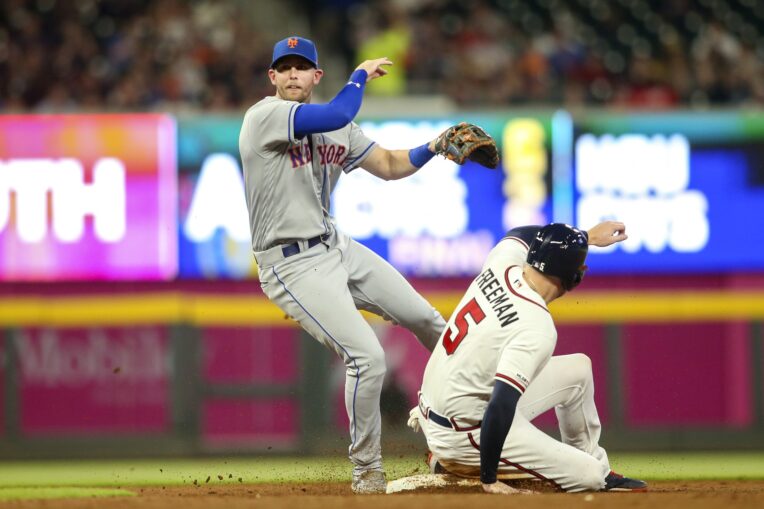
While the New York Mets haven’t made any notable free-agent signings just yet, they received some very encouraging news earlier this week, which should help them make some significant changes to their roster over the next couple of months.
Heading into this off-season, the Mets were slated to have enough financial flexibility to acquire at least one superstar player through free agency or the trade market. But with second baseman Robinson Cano receiving his second suspension for PEDs, the club won’t be forced to pay his $20 million salary in 2021 and the $4 million they earn from the Mariners, as part of the original deal from 2018, can instead be utilized to further improve the roster.
Along with gaining a massive chunk of payroll relief, Cano’s suspension also creates a much-needed opening at second base, which can help clean up some of the team’s internal logjam. Though there are a few players who deserve an opportunity to compete for the everyday role, it seems no one is a better fit for that spot than Jeff McNeil, who’s been forced to bounce around the entire field over the last two seasons.
Thanks to his stellar first-half performance through two minor-league levels (double-A and triple-A) in 2018, the Mets decided to promote McNeil to the major leagues in July and the former 12th-round selection certainly didn’t make them regret their decision. While it was clear he wasn’t a finished product and still had a few holes in his game, the 28-year old was able to showcase his outstanding ability to consistently put the ball in play along with his reliable defense on the right side of the infield.
Over 63 games in 2018, the left-handed batter earned 248 plate appearances, producing 11 doubles, six triples, three home runs, 19 RBIs, .359 BABIP, .368 wOBA, .142 ISO, 5.6% walk rate, 9.7% strikeout rate, 22.4% LD rate, 26.3% FB rate, 41.0% GB rate, 137 wRC+ score, 2.7 fWAR rating, along with a slashing line of .329/.381/.471/.852.
As for his defense, McNeil earned 460 2/3 innings at second base, finishing with the eighth-most DRS (four), tied for the 10th-highest OAA (two), tied for the 16th-highest UZR (0.4), the 15th-highest UZR/150 (1.4), and the 19th-highest defensive fWAR rating (1.9) among all second basemen who played at least 450.0 innings, according to FanGraphs.com.

Despite his strong finish to the 2018 campaign, the front office mistakenly acquired Cano in a blockbuster deal that off-season, which essentially forced the California State product off second base and into the outfield. As a result of this trade, the 6-foot-1 versatile infielder was transitioned into a utility player role – splitting time at third base, left field, and right field from 2019-2020 – and has since struggled to translate his career 4 OAA at second base over to any other position.
Now with Cano suspended for the entire 2021 campaign, McNeil has a clear opening to retake the starting job at his most natural position, which would also allow teammate Brandon Nimmo to move over to left field and become a much more effective defender than he was in center field. Since both of these players have shown flashes of above-average defense at each of these positions, making these positional changes should help improve the Mets’ run prevention moving forward.
With that in mind, there might be a chance the right-handed infielder could potentially compete for his first-career Gold Glove award if he makes some adjustments at second base next season. Looking at his results from the 2018 campaign, it appears the California native was positioned close to the bag fairly frequently but endured some issues when ranging to his left towards first base.
Here’s a breakdown of how McNeil performed at each of his finishing locations at second base in 2018:

While this visual above consists of just half a season’s worth of production, it displays that McNeil performed much more effectively when he finished behind the bag rather than between first and second base or in shallow right field. In addition, it also shows the veteran infielder enjoyed a solid amount of success when he was positioned at the edge of the grass, which suggests that’s an area where he should probably be positioned throughout the majority of next season.
Taking into account this information, if the one-time All-Star takes the time to improve his side-to-side movements over the off-season, then he’ll likely be able to become a much better overall defender through the remainder of his career. As a result, the man who’s referred to as “Squirrel” could make a solid case for himself to remain at second base beyond the 2021 campaign, which could force Cano to spend the remainder of his time as the designated hitter – assuming it returns in the future.
Considering McNeil isn’t afraid to surrender his body to make a highlight-reel catch in the outfield, which didn’t work out for him in 2020 as it caused him to battle through a knee injury, returning to the infield should help him stay on the field and in the lineup moving forward. Though his power metrics regressed from his stellar 2019 performance where he produced 23 home runs and a .214 ISO, a longer schedule and a healthy body should help him enjoy another All-Star worthy performance at the plate in 2021.
Moving McNeil back to the infield could also benefit the Mets in free agency, as they wouldn’t need to acquire an impact player for the right side of their infield, allowing them to focus their resources on the pitching staff, behind the plate, and in center field as well. So instead of targeting someone like DJ LeMahieu, management could increase their chances of landing George Springer, Trevor Bauer, and/or J.T. Realmuto this offseason.
With even more options available to them, the Mets shouldn’t have any issues transforming this roster into a championship contender in the near future, which will hopefully allow them to finally make the playoffs for the first time since 2016 while also starting to build a winning culture in Queens at the same time.














